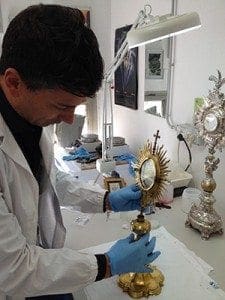Atlanta
Atlantans become patrons in preserving Vatican art
By NICHOLE GOLDEN, Staff Writer | Published December 11, 2014
ATLANTA—The before-and-after photos of the sacred vessels depict stunning transformations—the restoration of two Baroque monstrances and a silver incense thurible damaged by time and use.
In the labs of the Vatican Museums, makeovers of an artistic type take place.
Restorers, with the help of patrons of the arts worldwide, handle the delicate work of restoring the museum’s extensive collection of both sacred art and treasures of cultural or architectural significance.
It was the fledgling Georgia chapter of the Patrons of the Arts in the Vatican Museums that funded the restoring of the monstrances and censer.
Jay and Denise Mitchell, parishioners of the Cathedral of Christ the King in Atlanta, started the chapter a year ago. The Mitchells had become patrons through another American chapter, but after several trips to Rome decided to form one in Atlanta. The chapter encompasses all of Georgia.
“We started with 11,” said Denise Mitchell. Its membership has now grown to 27 people.
Their first family trip to Italy was to accompany a choral group from Christ the King.
“We were just mesmerized by Rome,” said Jay Mitchell.
While doing research for a subsequent trip, Mitchell learned about the patronage program, saw the benefits, and signed up on the spot.
Varying membership levels are available. Patrons’ benefits include private, complimentary tours of the Vatican Museums, skipping the line at St. Peter’s Basilica, access to the Vatican Gardens for a morning tour, to restoration labs and the Sistine Chapel, as well as preferred seating at papal audiences and Masses.
But the ultimate benefit is supporting efforts to preserve the art for future generations.
“It’s the world’s museum,” said Jay Mitchell. “It’s so exciting. It’s amazing … this art collection.”
The Mitchells and their three sons have enjoyed seeing the gardens and have had unexpected Vatican experiences they call “divine intervention,” including being asked to bring up the offertory gifts at Mass at St. Peter’s Basilica.
While they hope their sons learn about art, the Mitchells said the boys were most impressed with a close-up look at the helipad for the pope’s helicopter.
“We were just blown away,” said Denise Mitchell about their visit as patrons. “We kept going back.”
‘Best way to see the Vatican’
Father Mark Haydu, LC, international director of the patrons program, recently visited Atlanta. He first began his work at St. Peter’s giving Scavi tours, the name given to the excavations underneath St. Peter’s Basilica which have revealed a necropolis and the tomb of St. Peter.

Father Mark Haydu, LC, is the international director of the Patrons of the Arts of the Vatican Museums program. Father Haydu recently visited Atlanta to promote the program.
Now he travels and makes connections to promote the patrons program. Father Haydu emphasizes that the Vatican Museums do not have a tax base from which to draw support.
“It’s the best way to see the Vatican,” he said of patron membership.
While visiting Georgia, Father Haydu was a guest homilist at St. Brendan the Navigator in Cumming. He also signed copies of his book, “Meditations on Vatican Art: Angels,” which unites Vatican masterpieces with Scripture-based meditation, prayer, and Ignatian spiritual activities.
Father Haydu has had the opportunity to be with Pope Francis during a handful of events or meetings. He said that after learning that Americans are the primary benefactors of the Vatican Museums, Pope Francis expressed curiosity about their interest in supporting arts halfway around the world.
Father Haydu said he answered by speaking about the roots of American generosity.
“They’ve been blessed,” he told the pontiff. “They recognize the importance of something bigger than themselves.”
The Patrons of the Arts in the Vatican Museums is a 501c(3) interfaith group that is committed to the restoration while furthering understanding and knowledge of members of these works through lectures, meetings and visits to the Vatican.

A Vatican Museums restorer works in the laboratory on a Baroque period monstrance. The new Georgia chapter of the Patrons of the Arts of the Vatican Museums funded the restoration of two monstrances and a censer, dating to the late 1700s.
A 2015 “wishbook” of restoration projects outlines the projects the museum staff hopes to begin in the coming year. Projects include preservation of a wooden door from 1632 with the coat of arms of Pope Urban VIII Barberini; cleaning and touching up of the fresco, “Washing of the Feet,” by Giorgio Vasari; and restoration of a Bundu costume from Sierra Leone.
The projects are not just limited to religious or cultural pieces but also include work in the gardens, lighting upgrades, technology, and restoration of literary collections.
The wishbook also features the recently completed restoration of the tapestry of “St. Paul Preaching in Athens.” The seven-year project employed re-texturing techniques of alternate sewing and replenishing areas of missing yarn.
The next sponsored project of the Georgia chapter will be the “Statue of Horus.” The Egyptian statuette dates from the first century before Christ and depicts one of the most ancient deities of the Egyptian pantheon. He was considered the protector of the monarchy since the early dynasties. The statuette, which has a hollow space, was used as a funerary urn for the mummy of a falcon and was possibly placed in one of the cemeteries dedicated to the god. Its surfaces are corroded and several portions are encrusted with corrosive salt byproducts. It is possible that in the past this piece was poorly restored using a solvent that was too strong. There is a fissure in the back of the statuette.
The restoration project is estimated to cost $6,700 and the chapter’s hope is to restore this ancient bronze for the next 2,000 years.
For Jay Mitchell, becoming a patron family has helped them to develop the spiritual connection to art, and they suspect that it will for others.
“As Catholics, it spoke to us,” said Mitchell.